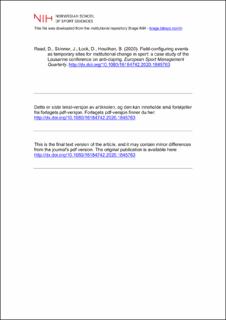| dc.contributor.author | Read, Daniel | |
| dc.contributor.author | Skinner, James | |
| dc.contributor.author | Lock, Daniel | |
| dc.contributor.author | Houlihan, Barrie | |
| dc.date.accessioned | 2022-05-11T09:45:20Z | |
| dc.date.available | 2022-05-11T09:45:20Z | |
| dc.date.created | 2020-11-30T15:58:47Z | |
| dc.date.issued | 2020 | |
| dc.identifier.citation | European Sport Management Quarterly. 2020. | en_US |
| dc.identifier.issn | 1618-4742 | |
| dc.identifier.uri | https://hdl.handle.net/11250/2995229 | |
| dc.description | Dette er siste tekst-versjon av artikkelen, og den kan inneholde små forskjeller fra forlagets pdf-versjon. Forlagets pdf-versjon finner du på tandfonline.com / This is the final text version of the article, and it may contain minor differences from the journal's pdf version. The original publication is available at tandfonline.com | en_US |
| dc.description.abstract | Research question: Institutional work by actors (e.g. organisations or individuals) to create, maintain or disrupt institutions requires redefining what is considered legitimate behaviour. Furthermore, research indicates that field-configuring events (FCE), such as conferences, which temporarily unite actors, are important junctures for institutional processes. Research is yet to address how FCE intersect with the effectiveness of institutional work. The aim of this paper is to explore how (i) the legitimacy of an actor at the time of an FCE, and (ii) the co-location of actors at an FCE impact institutional work effectiveness. Research methods: The 1999 Lausanne Conference is used as a case study because it led to significant institutional disruption in the field of anti-doping through the creation of the Lausanne Declaration. To analyse these institutional processes, a qualitative thematic analysis of 624 newspaper articles and archival documents from the conference was conducted. Results and Findings: Firstly, we demonstrate that institutional maintenance can fail if an actor’s legitimacy is under challenge at the time of an FCE. Secondly, the co-location of likeminded actors can create a consensus that acts as a cue to enable institutional disruption. Implications: Based on the findings, suggestions are made to inform decision-making processes about institutional work. Initial categorisation of FCE conditions are presented and five propositions are made for future exploration. | en_US |
| dc.language.iso | eng | en_US |
| dc.subject | legitimacy | en_US |
| dc.subject | field-configuring event | en_US |
| dc.subject | institutional work | en_US |
| dc.subject | anti-doping | en_US |
| dc.subject | world anti-doping agency (WADA) | en_US |
| dc.title | Field-configuring events as temporary sites for institutional change in sport: a case study of the Lausanne conference on anti-doping | en_US |
| dc.title.alternative | Field-configuring events as temporary sites for institutional change in sport: a case study of the Lausanne conference on anti-doping | en_US |
| dc.type | Peer reviewed | en_US |
| dc.type | Journal article | en_US |
| dc.description.version | acceptedVersion | en_US |
| dc.source.pagenumber | 23 | en_US |
| dc.source.journal | European Sport Management Quarterly | en_US |
| dc.identifier.doi | 10.1080/16184742.2020.1845763 | |
| dc.identifier.cristin | 1854343 | |
| dc.description.localcode | Institutt for idrett og samfunnsvitenskap / Department of Sport and Social Sciences | en_US |
| cristin.ispublished | true | |
| cristin.fulltext | postprint | |
| cristin.qualitycode | 2 | |
